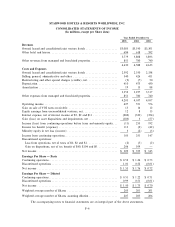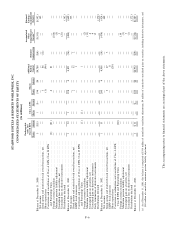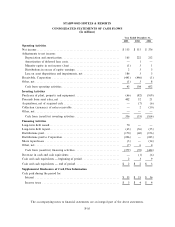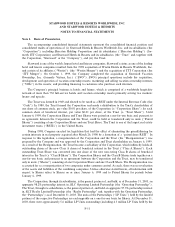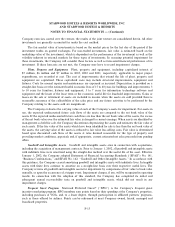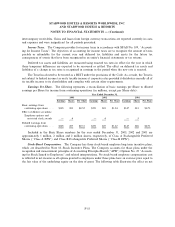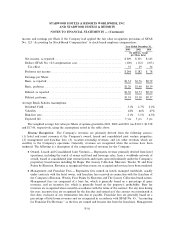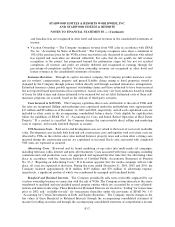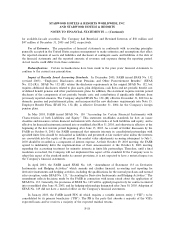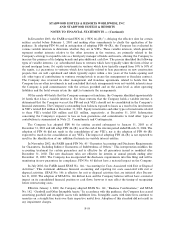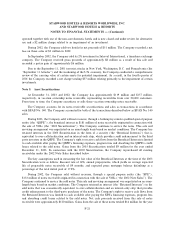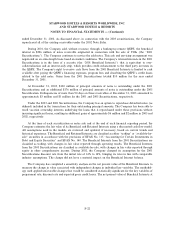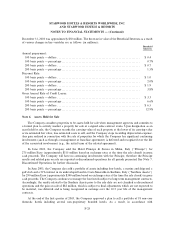Starwood 2003 Annual Report Download - page 80
Download and view the complete annual report
Please find page 80 of the 2003 Starwood annual report below. You can navigate through the pages in the report by either clicking on the pages listed below, or by using the keyword search tool below to find specific information within the annual report.STARWOOD HOTELS & RESORTS WORLDWIDE, INC.
AND STARWOOD HOTELS & RESORTS
NOTES TO FINANCIAL STATEMENTS Ì (Continued)
SPG is provided as a marketing program to the Company's properties, including as incentives to Ñrst time
buyers of VOIs. The cost of operating the program, including the estimated cost of award redemption, is
charged to properties based on members' qualifying expenditures. Revenue is recognized by participating
hotels and resorts when points are redeemed for hotel stays.
The Company, through the services of third-party actuarial analysts, determines the fair value of the
future redemption obligation based on statistical formulas which project timing of future point redemption
based on historical experience, including an estimate of the ""breakage'' for points that will never be redeemed,
and an estimate of the points that will eventually be redeemed. These factors determine the required liability
for outstanding points. The Company's management and franchise agreements require that the Company be
reimbursed currently for the costs of operating the program, including marketing, promotion, communications
with, and performing member services for the SPG members. Actual expenditures for SPG may diÅer from
the actuarially determined liability.
The liability for the SPG program is included in other long-term liabilities and accrued expenses in the
accompanying consolidated balance sheets. The total actuarially determined liability as of December 31, 2003
and 2002 is $201 million and $175 million, respectively.
Legal Contingencies. The Company is subject to various legal proceedings and claims, the outcomes of
which are subject to signiÑcant uncertainty. SFAS No. 5, ""Accounting for Contingencies,'' requires that an
estimated loss from a loss contingency should be accrued by a charge to income if it is probable that an asset
has been impaired or a liability has been incurred and the amount of the loss can be reasonably estimated.
Disclosure of a contingency is required if there is at least a reasonable possibility that a loss has been incurred.
The Company evaluates, among other factors, the degree of probability of an unfavorable outcome and the
ability to make a reasonable estimate of the amount of loss. Changes in these factors could materially impact
the Company's Ñnancial position or its results of operations.
Derivative Financial Instruments. The Company enters into interest rate swap agreements to manage
interest rate exposure. The net settlements paid or received under these agreements are accrued consistent
with the terms of the agreements and are recognized in interest expense over the term of the related debt. The
related fair value of the swaps is included in other liabilities or assets.
The Company enters into foreign currency hedging contracts to manage exposure to foreign currency
Öuctuations. All foreign currency hedging instruments have an inverse correlation to the hedged assets or
liabilities. Changes in the fair value of the derivative instruments are classiÑed in the same manner as the
classiÑcation of the changes in the underlying assets or liabilities due to Öuctuations in foreign currency
exchange rates.
The Company does not enter into derivative Ñnancial instruments for trading or speculative purposes and
monitors the Ñnancial stability and credit standing of its counterparties.
Foreign Currency Translation. Balance sheet accounts are translated at the exchange rates in eÅect at
each period end and income and expense accounts are translated at the average rates of exchange prevailing
during the year. The national currencies of foreign operations are generally the functional currencies. Gains
and losses from foreign exchange and the eÅect of exchange rate changes on intercompany transactions of a
long-term investment nature are generally included as a separate component of stockholders' equity. Gains
and losses from foreign exchange rate changes related to intercompany receivables and payables that are not of
a long-term investment nature are reported currently in costs and expenses and amounted to a gain of
$4 million, $33 million and $27 million in 2003, 2002 and 2001, respectively. The $33 million gain in 2002
includes a $30 million gain recorded in selling, general, administrative and other expenses related to the mark-
to-market of U.S. dollar intercompany receivables in Argentina as a result of the devaluation of the Argentine
Peso. The $27 million gain in 2001 includes a $24 million gain from the same U.S. dollar Argentine
F-14


